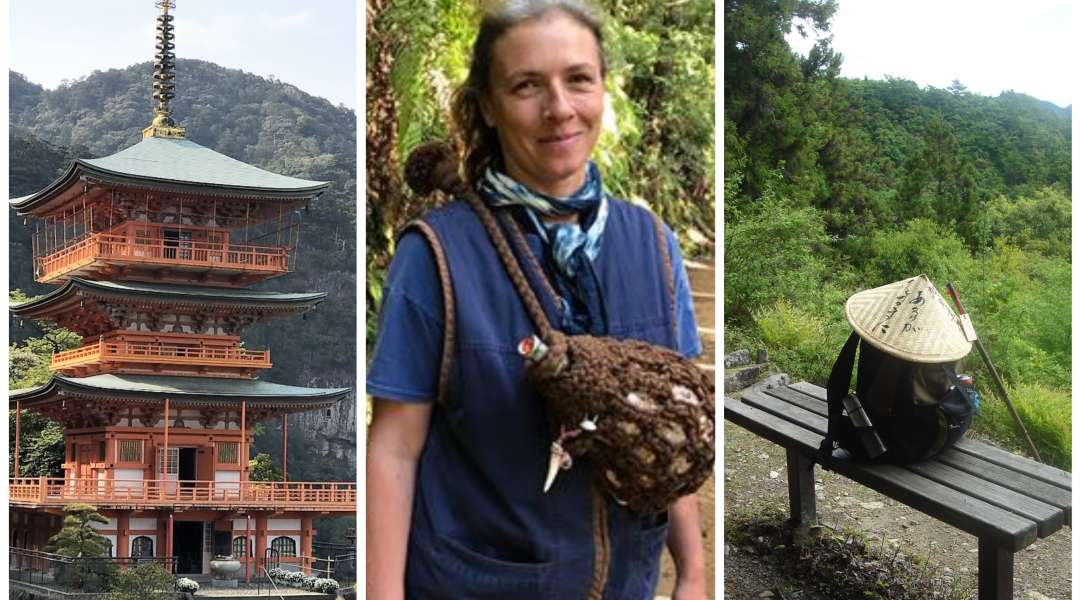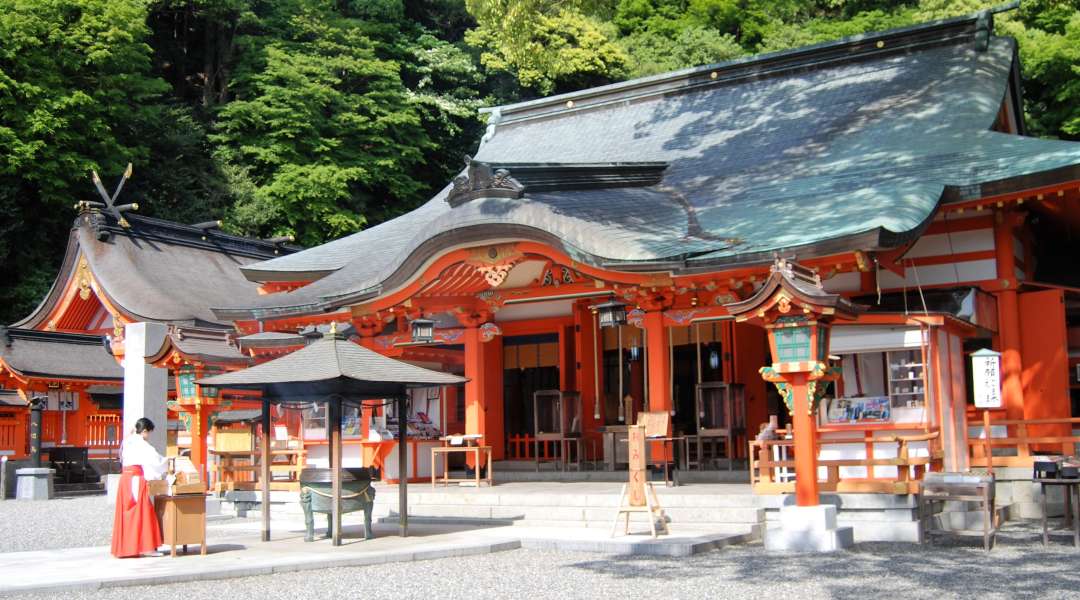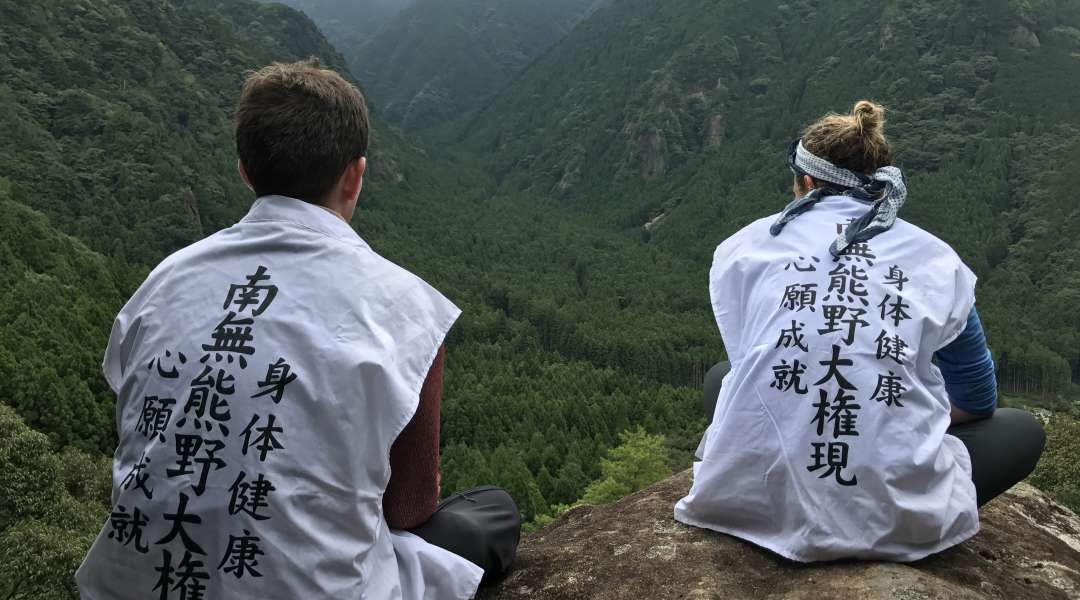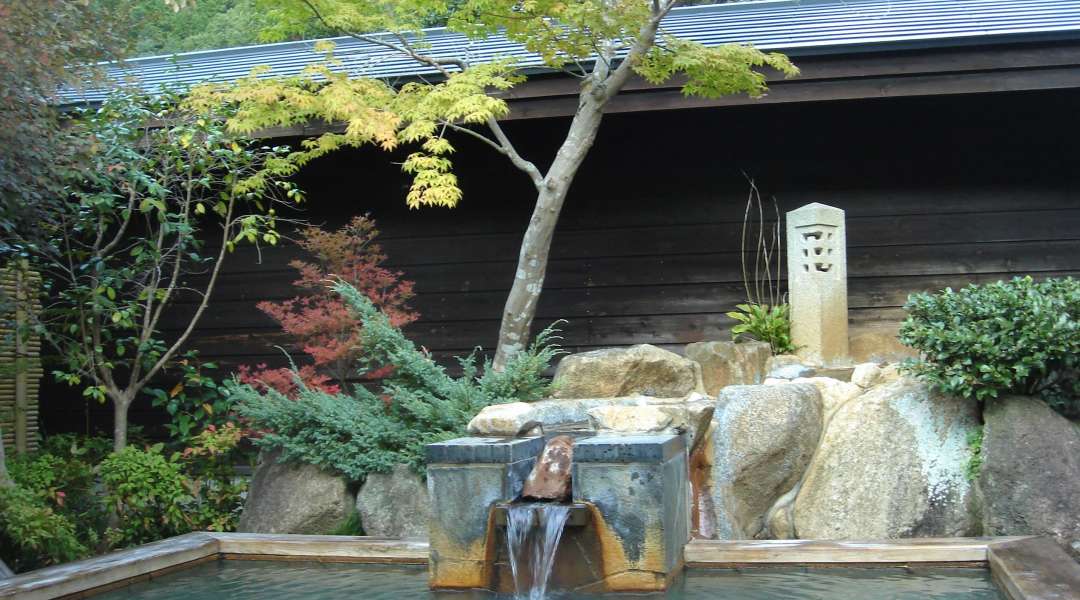
Alena was born in East Germany and the minute the Berlin Wall fell, she seized the opportunity and ventured abroad. Then, many years later she found herself working in Tokyo when the March 11 2011 Tohoku Earthquake and Tsunami struck Japan. She always wanted to live in the countryside and this created an opportunity to rethink her city life. That's when she made the decision to move to Wakayama prefecture on the Kii Peninsula where she is a Certified Forest Therapy Guide, a travel writer, an experienced facilitator and so much more. She also has her own initiative called Kii Monogatari through which she cultivates nature immersions and assists visitors with spiritual exploration. Alena's life has been a real journey shaped by her resolve and fate called "en" in Japanese. Find out about spiritual travel and exploring the Kii Peninsula, home to Wakayama, Nara, and Mie prefectures, just south of Osaka.

Hi, thanks for talking to us today. Could you tell us about yourself?
I am originally from East Germany and I came to Tokyo, via Berlin and London, in 2005. In summer 2011 I moved to remote Kumano in the south of the Kii Peninsula where I live, work and play now. To live in a small village in rural Japan was a dream that connects back to my childhood in East Germany. I love living in the countryside and being in nature. My life took a big turn in 1989 when the Wall that separated East and West Germany and Eastern and Western Europe came down. Now I could travel the world, something I always longed for provided I had money. Hence, I wanted to build a career fast and so my stays abroad were first inspired by study and work.
I moved to Bavaria and studied Vietnamese language and Southeast Asian Studies at Passau University. I got a scholarship and went on a year abroad to Hanoi to learn Vietnamese but because we had Russian as a foreign language in East Germany, I couldn’t speak any English! After I came back from Hanoi, I went straight to London to learn English more or less from scratch. Within two years I pushed myself from almost zero to passing certificates that allowed me to study for a Masters in Asia-Pacific Studies at the School of Oriental and African Studies (SOAS) in London. In 2000, after some other jobs, I began to work at the Europe Japan Centre (EJC), a research business that worked for Japanese clients. At that time, I had not been to Japan yet, and I desperately wanted to go.

How did you end up working and living in Japan and what was it like?
I took up Japanese language classes on weekends and I looked for a way how to get to Japan but not just be a tourist. This is when I came across the Executive Training Program (ETP) Japan organised by the European Union which was a 1.5 year Japanese business and language training program. Later on I worked as the Assistant Director for the Japan Market Expansion Competition (JMEC), a mini-MBA training program in Tokyo. Work was very busy and life was in the fast lane. Tokyo is a fascinating and exciting place that totally sucked me in. Then came March 11 2011.
I enjoyed each big city immensely but deep in my heart I wanted to live in the countryside and wanted to be surrounded by forests and mountains. Yet, leaving a corporate job, a high-flyer lifestyle and the conveniences of a big city like Tokyo was no easy step. The Fukushima nuclear reactor melt-down in the wake of the tsunami that swallowed the Tohoku Coast on March 11 2011 gave me the excuse to move further southwest, namely to the Kii Peninsula, and this is where my story of the Kii Monogatari begins.
When I moved out of Tokyo and to Kumano, I had to re-adjust. I knew that but it was still a challenge to find a place to live and a job to do in the "deep countryside". So much depends on personal connections and introductions and on what the Japanese call "en", variously translated as fate, chance or opportunity. En brought me to a Japanese house in a small village along the Kumano Kodo trail where I live now. En brought me to my Shugendo teachers to whom I became an apprentice. En brought me to the local tourism office where I trained to become a licensed tour guide. En brought me to Forest Therapy.

Could you explain what the Kii Monogatari is?
Kii Monogatari is my narrative for an envisioned healing hub in the mountains and forests of the Kii Peninsula that has taken ten years to conceive. I take the three sacred places – Koyasan, Yoshinoyama and Kumano – and the pilgrimage trails that connect them as the base for activities that encourage and cultivate nature immersions and spiritual exploration.
I consider the whole peninsula as my dojo, a training place, with its forests, mountains, rivers, waterfalls, the ocean, friendly rural communities and sacred spots. This is where nature meets spirituality, and tradition meets sustainability. This is where the elements (earth, water, fire, wind) are palatable, the mind can relax and the soul finds a way home.
I believe that the Kii Peninsula is the ideal place in Japan for a slow retreat, for an introspective pilgrimage, for a vision quest, for restorative walks, for engaging activities and sensuous experiences in the realms of nature and spirit.
The legendary “J-Wellness” lies in abundance at my doorsteps: Onsen, monastery stays, vegetarian Shojin Ryori cuisine, healthy Medicinal Cooking, Japanese herbal teas and aromatherapy oils, Buddhist chanting and sutra copying, incense appreciation, waterfall purification, Shinto prayers, mindfulness in nature, walking meditation, the sounds of singing bowls and the Hora conch shell. If this resonates with you, then why not come and experience this with me.
I want to share my world with you as a travel companion, a "local" guide and a facilitator. I want to open the doors for you to hidden places of nature, to rural communities and places of worship and prayer. I operate on a small scale and my services are personalized and tailor-made. They are meant to be on-the-ground (and grounding) and in-person (and embodied).

What is Forest Therapy and how did you become a Certified ANFT Forest Therapy Guide?
Forest Therapy is a healing practice where through a guided immersion in a forest and the engagement of all senses a state of well-being is achieved. This is a research-based practice that was first conceived in Japan in the 1980s as Shinrin Yoku ("Forest Bathing") and it aims at relaxation and improving your health but also nurturing a heartful relationship between people and nature.
I came across Forest Therapy around 2015 when it was not an international trend yet. At the time I had begun to go to Yoshinoyama frequently for immersive training in the ancient mountain monk tradition called Shugendo, the way of testing and training in nature. I saw a leaflet for a Shinrin Therapy walk in the Yoshino area and I attended the walk. Then I noticed another leaflet that a new course for becoming a Shinrin Therapy Guide in Yoshino would start soon. I enquired whether I could participate and received an OK, and a year later I qualified as a licensed guide in Japan. A couple of years later I was put in touch with the founder of the Association of Nature and Forest Therapy (ANFT) in the US who had come to Japan for some research. I got interested in his approach and method and decided to also join their training last year so I am also certified as an ANFT Forest Therapy Guide.

Which hikes in Japan have made the most lasting impression on you? Why?
It was my first and subsequent multi-day walks on the Nakahechi and Kohechi routes of the Kumano Kodo pilgrimage trails on the Kii Peninsula over ten years ago! I was so impressed that I decided to quit my job and my flat in Tokyo, pack up and move down to Kumano in the south of the peninsula. It was love at first sight, or shall I say, a calling?
Also the walks around the Buddhist monastery of Koyasan. There is the Women’s Pilgrimage trail and the Choishimichi trail and for a longer hike there is the Kohechi route of the Kumano Kodo, a 4-day walk that connects Koyasan with Kumano. I recommend to explore Koyasan first, then walk the Kohechi down to Kumano and explore the Nakahechi and the Three Kumano Grand Shrines. This can easily become a 14 days schedule.

Which places in Japan would you recommend to people looking for spiritual travel?
Well, I recommend first the Kii Peninsula because there are several spiritual centres, including the Ise Grand Shrine, considered to most venerable Shinto shrine in Japan, then there is the Esoteric Buddhist mountain monastery of Koyasan which was set up by Kobo Daishi or Kukai, one of Japan’s most venerated Saints. There is the mountain ascetic monk tradition called Shugendo with its main centre on Yoshinoyama and there is also the syncretic sacred place of the Kumano Sanzan, the Three Grand Shrines of Kumano. You can experience a great variety of spiritual traditions here that have a history of over 1,200 years. Plus there are forests and mountains as far as you can see and many "power spots" where you can experience the natural environment as an embodiment of the divine.

What kind of places off the beaten track would you recommend around the Kii peninsula? When is the best time to visit?
Pilgrimage trails connect the mentioned spiritual centres along which there are many more small temples and shrines, some of which are secluded deep in the forest. For example, there is Tamaki Shrine with its mystical atmosphere where you can also find some thousand year-old cedar trees. Or, Tenkawa Shrine, which is one of the main shrines in Japan where Saraswati (in Japanese Benzaiten), a female deity of art, music and water, is worshipped.
The best way to get to these locations is by rent-a-car and driving across the Kii Peninsula. National Roads 168 and 169 that run north-south across the Kii Peninsula are a driver’s paradise with almost no traffic lights and curvy roads through the mountains and forests.
The best time to visit is spring (April, May) and autumn (October, November). Summer (July, August) is a beautiful season too when you will have a chance to bath in a river, stand under a waterfall or swim in the ocean, but is very hot and humid. Not recommended are June (raining season), September (typhoon season) and December to March (snow in the north of the peninsula).

Can you give us any travel tips for people who are visiting the Kii Peninsula for the first time?
The Kii Peninsula is made up of three prefectures: Wakayama prefecture, Nara prefecture, and Mie prefecture. I recommend flying into Kansai International Airport (KIX) rather than flying into Tokyo airports. KIX is located just north of Wakayama City in Wakayama Prefecture from where you have good access to the Kuroshio Express train that takes you all around the peninsula, including major destinations such as Tanabe, Kushimoto, Nachi-Katsuura and Shingu. The views from the train are very scenic as the rail tracks run along the shoreline and you have the mountains on one side and the ocean on the other side. Riding the Kuroshio train in the other direction will take you to Osaka and to Kyoto where you can continue your Japan trip. Local busses from Tanabe or Shingu Stations take you to many more destinations and to the trailheads of the Kumano Kodo trails.
It is advisable to book accommodations well in advance, if you want to organise the trip yourself, as walking the Kumano Kodo trails has become very popular in recent years. Please be aware that many locations are very remote and there is no convenience store to easily pick up some food or withdraw money from an ATM. I strongly suggest bringing cash in Japanese yen with you and to to book accommodations with dinner and breakfast included. Most of the time they can also provide you with a lunch box. More and more accommodations also provide a vegetarian and a gluten-free option.
My insider tip would be to rent a car and drive around the peninsula. You need to bring an International Driving License and you can pick up a rental car at Kansai International Airport. It is easy to navigate with your smartphone and many cars also have an English navigation system on board. Driving yourself will give you access to locations that you cannot reach by public transport. The south of the Kii Peninsula is considered remote by Japanese standards!

Do you have any food recommendations?
The Kii Peninsula has much to offer on the culinary front. There is the Buddhist vegetarian cuisine, called Shojin Ryori, which you can eat at temple lodgings on Koyasan. Then there is seafood in all locations along the coast, and maguro (tuna) in Katsuura Port. There is also great river fish, such as ayu (sweetfish) and amago (red-spotted masu salmon). For lovers of meat, there is Kumano beef, a kind of wagyu, and wild boar hotpot. The local specialties are mehari sushi (rice wrapped in pickled mustard leave) and kakinoha sushi (rice with a slice of mackerel or salmon and wrapped in a persimmon leave).
Wakayama Prefecture is a fruit’s paradise. It is the top producer of satsuma mandarins, which you can find year round, and of ume, the Japanese plum, that you will likely have as umbeboshi (sour-salty pickled) in your Japanese breakfast. Ume also means umeshu, the sweet plum wine. Then we have persimmon and many other fruits in autumn.

This month we’re focusing on the word ‘natsukashii’, meaning 'nostalgic' or 'full of fond memories'. What is your favourite natsukashii memory from Japan?
I am still living in Japan and can "update" my memories on a daily basis but going back to my early days in Kumano, I have fond memories of my first few times trying to play a Hora, a conch shell. Either I produced no sound or a very strange one. It took me a long time to get a basic sound and even longer to play a basic tune.
You can find out more about Alena and Kii Monogatari on social media: Instagram and Facebook!

















































